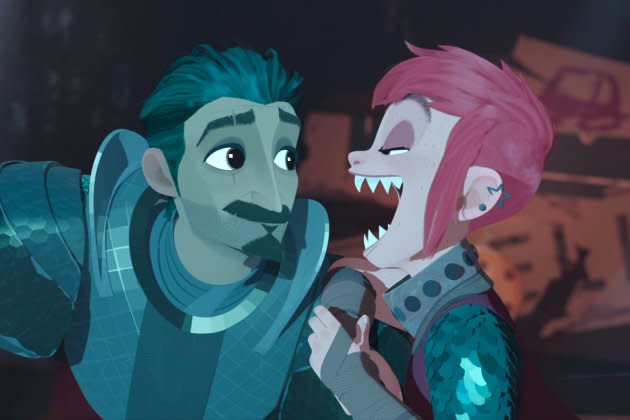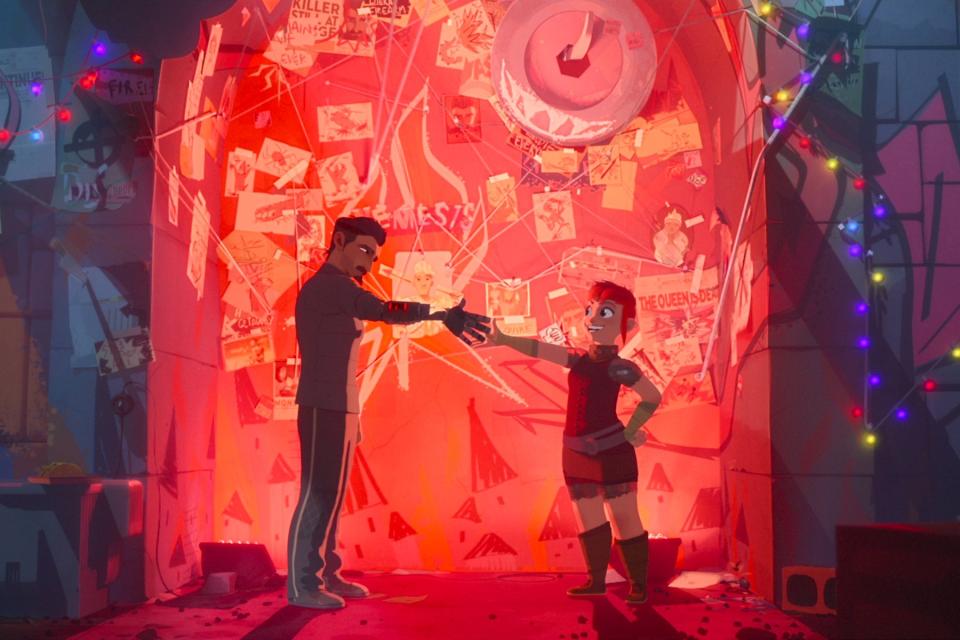‘Nimona’: Netflix’s Remarkable Trans-Rights Animated Movie Is Here
- Oops!Something went wrong.Please try again later.

The seven-year production of the latest Netflix animation feature, Nimona, was a rocky one. The film, based on ND Stevenson’s webcomic about a sadistic little shapeshifter sidekick with a heart of gold, survived biblical hurdles in its leap from ND’s panels to TV and big screens, including a studio acquisition, a whole pandemic, and a studio closure. Nimona’s epic journey is unlike anything else in feature animation history. But when a film boasts a subversive protagonist full of fiery, offbeat, punk-rock LGBTQ+ energy in a family film with a unique pro-trans message, a special character like Nimona is every inch worth fighting for.
“What became very clear to us was that Nimona was a story that hadn’t been told yet. The reels were dancing around it a little bit, and that was the connection to the LGBTQ+,” co-director Nick Bruno tells Rolling Stone. “Nimona is a universal story. It’s a love letter to all those who’ve ever felt misunderstood but in particular, what makes it stand out, and what got its connection with the graphic novel was leaning into those themes.”
More from Rolling Stone
The Transphobic War on the Word 'Cis' Goes Back an Entire Decade
'America Is Queer' and Drag Icon Taylor Mac Is Preaching the Gospel
The feature follows Lord Ballister Blackheart (Riz Ahmed), a knight wrongfully convicted of a crime on his coronation. During the tragic event, Blackheart’s boyfriend and fellow knight, Ambrosius Goldenloin (Eugene Lee Yang), cuts off his arm, but Blackheart escapes. Wanted and hated by the entire futuristic-medieval kingdom of the realm, Blackheart’s fate changes when Nimona (Chloë Grace Moretz), a teenage girl obsessed with murdering and the ability to shapeshift into any animal she desires (a trans allegory, to be sure), arrives at his doorstep. She self-hires herself as his sidekick. With no allies except her, Blackheart accepts her offer, and the two try to prove his innocence to the kingdom.
In 2019, Troy Quane and Nick Bruno flocked their feathers as a directing duo through their spy-turned-pigeon buddy action-comedy Spies in Disguise, starring Tom Holland and Will Smith. Produced by the former Greenwich-based animation studio Blue Sky Studios, best known for the Ice Age and Rio films, Spies was the first and final film distributed by Disney, which acquired the studio via its 2019 Fox acquisition.

At the time, Nimona was in production under Blue Sky and at the helm of Patrick Osborne (Academy Award-winner for the Disney short Feast), and would’ve been his feature debut. Following Spies’ release, Bruno and Quane got brought on to voice their inputs at the first set of reels on Nimona as they were looking forward to an extended vacation.
When the pandemic hit a few months later, Nimona breathed her fire as animators shifted their work from the studio to home. After a year of remote production and 75% of the animation completed, Disney shut down Blue Sky to cut the costs of running three separate animation studios (Blue Sky, Pixar, and Walt Disney Animation Studios). Following Blue Sky’s unfortunate shuttering, Nimona was shopped around until it caught the eye of Annapurna Pictures’ Megan Ellison. After seeing animation footage and rough animatics, Ellison hopped on board to rescue Nimona from her ashes, with British-based studio DNEG (Ron’s Gone Wrong) completing the animation.
Because of their creative input, Quane and Bruno were given the director job and made the film as collaborative as possible. The film would be the first feature with a prominent LGBTQ+ theme at the studio.
“Our voices started to stand out a little bit in those rooms. When we were given the reins, by that point, it didn’t matter if we were tired; we were excited,” says Bruno. “This is a very important movie. We were excited to make it great. It wasn’t just our story to tell but we opened it up to everybody at the studio. Anybody who could speak to those LGBTQ themes and felt comfortable.”
While directors Quane and Bruno aren’t part of the LGBTQ+ community, they proved their allyship by listening to the voices of queer artists, the trans and non-binary ND Stevenson (who co-produces the film) included, bringing as much authenticity to Nimona as possible, whether it be in Nimona’s queer personality or the relationship between Blackheart and Goldenloin.
“The most humbling part was opening it up to people at Blue Sky. We had a group of friends of the film who’d come in, and we’d have lunch, and people would share their experience and their stories, and it was our job to listen and make sure we were stewards for those stories and those experiences,” shares Quane. “[We wanted to] make sure that it felt like an honest depiction in the film — that we were truly representing the voices and the courage of people we’re sharing them with.”
Nimona’s creative team was bewitched by the techno-medieval landscape Stevenson provided, where knights in shining armor wield laser guns. Furthering his vision, the production designers took inspiration from artist Charley Harper for the graphic design, geometric shape patterns for the character designs, and Disney background painter Eyvind Earle of Sleeping Beauty fame.
“We’ll take credit for adding the flying cars, though,” Quane retorts.
As advanced as the futuristic environment was visually, the team found innovation by juxtaposing the setting with its people and their antediluvian mindsets. Throughout Nimona, Blackheart and Nimona face the influential, classist, and conservative government organization, The Institution of Law Enforcement and Heroics, sworn to protect the citizens from monsters but instead brainwashes the residents through fearmongering messages mainly stemming from the Institute’s leader, The Director (Frances Conroy).
“It’s a society that’s moved forward in time with the technology, but the thinking is still a little locked in the past,” Quane offers. “So it was essential to represent the idea that we have biases. We have our thoughts. We don’t necessarily grow forward with them, as we should the way everything else seems to in the world. And really, it’s a reflection of how we are even today in our world.” The Institute’s white-and-gold color scheme on the knight’s armor, director’s robe, and base architecture amplified the organization’s conservative sensibilities.
With a society rooted in control and conservatism, Nimona’s outward, unabashedly punk shell supports the film’s remarkable trans allegory. Amid their mission, Blackheart, once trained to destroy creatures like Nimona, learns to open his mind and accept her for who she is.
One of the filmmaker’s most significant decisions was for Nimona to be pink whenever she shapeshifted, as opposed to the source material where she embodies every animal’s attributes and color. Most of the time, Nimona shapes as a human girl but doesn’t refer to herself as a people, despite wanting to be accepted by them. Discussing Nimona’s human form, Bruno says, “Let’s not forget, she’s a shapeshifter, and this is still a form that she chooses more often than anything else. And in a way, it’s saying, I want to be part of the people. But at the same time, I’m not just going to be what they want me to be. I’m going to be unapologetically myself and my true spirit, which is a little mischievous sometimes.”
“Most times, if you’re telling a story about a teenage girl as your lead character, it’s a story of discovery. Who am I, what do I want? But in this world, Nimona comes in and kicks you in the face and says, ‘Here’s who I am,’” Quane asserts.” She knows who she is, and she will let you know through the movie.”
Best of Rolling Stone

